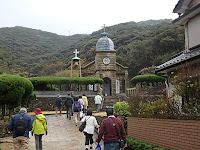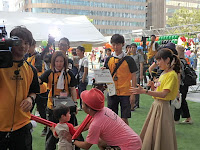December 24, 2018

Ordinary people on hand to receive tourists for World Heritage Christian sites on remote Japanese islands
Japan saw its Christian-related historical sites in the westernmost part of the Japanese Archipelago inscribed on the World Heritage list in July 2018. A joyous mood spread in regions involved just after the incident, but old Christian churches on remote islands in Nagasaki Prefecture, as part of the World Heritage sites, stand to receive visitors in a calm atmosphere.
 All but one of the 12 sites are actually the villages or remains linked to the so-called hidden Christians, the people who maintained their faith secretly in the absence of Western missionaries amid the ban on Christianity from the end of the 16th century. The exception is Oura Cathedral, Japan's oldest Christian church built in Nagasaki City in the 1850s.
All but one of the 12 sites are actually the villages or remains linked to the so-called hidden Christians, the people who maintained their faith secretly in the absence of Western missionaries amid the ban on Christianity from the end of the 16th century. The exception is Oura Cathedral, Japan's oldest Christian church built in Nagasaki City in the 1850s. Four of the World Heritage sites are located in largely isolated areas on the Goto Islands, which lie about 100 kilometers west of Nagasaki.
Four of the World Heritage sites are located in largely isolated areas on the Goto Islands, which lie about 100 kilometers west of Nagasaki.Accompanied with an unprofessional guide, a group of tourists visited a stone-built church which stands on a hill right behind a village of Christians on Kashiragajima Island. They were asked to take off their hats and refrain from talking loudly within the church, because it is a place of prayer.
 The church is usually closed, but three old local women, who are Christians, are on hand to open the door for tourists by turns, the guide said.
The church is usually closed, but three old local women, who are Christians, are on hand to open the door for tourists by turns, the guide said.The guide introduced herself as a "pilgrimage guide." She started the job a few years ago after attending a course opened by a local nonprofit organization, called "Pilgrimage College."
The number of tourists to the Goto Islands has been growing since around the registration of the sites as the World Heritage, but the regions involved remain relatively unsophisticated.
 The Goto Islands are formed by about 140 isles, where about 57,000 people live. The local economy depends mainly on fishery.
The Goto Islands are formed by about 140 isles, where about 57,000 people live. The local economy depends mainly on fishery.Because there are no major tourist bus companies, staff bus guides are limited. This is the reason why local tourist organizations are trying to raise guides for tourists from among ordinary people.
The number of amateur guides is precisely unknown, but 20 or so people are believed to be so registered in the region.
"I studied together with a few others, but those who actually work as pilgrimage guides, like me, are limited, maybe three or four," the guide said. "This job is tough, you know, sometimes we have to be on a long bus ride, sometimes aboard a boat."
 Every one of 10 Goto islanders is said to be a Christian. "I am not a Christian, but I love this job," she said.
Every one of 10 Goto islanders is said to be a Christian. "I am not a Christian, but I love this job," she said.Another amateur guide took care of the tourists on the second half of their tour on the islands. "I studied for becoming a guide at a course sponsored by the local government," she said, "because I like talking with people."
 The local authorities hope to take the occasion to bolster the economy in the region as a whole, at a time when its mainstay business, fishery, is not active enough. But they also have to be careful about preserving the historical environment around the sites. Christianity was introduced into Japan in the middle of the 16th century, and just after that, Christians spread quickly in the western part of Japan. But a crackdown on missionaries and Christians started soon, toward the end of the century.
The local authorities hope to take the occasion to bolster the economy in the region as a whole, at a time when its mainstay business, fishery, is not active enough. But they also have to be careful about preserving the historical environment around the sites. Christianity was introduced into Japan in the middle of the 16th century, and just after that, Christians spread quickly in the western part of Japan. But a crackdown on missionaries and Christians started soon, toward the end of the century.Many Christians fled from the Nagasaki region in search for safer places, on the Goto Islands or elsewhere, but they found only environmentally hard places for them to resettle, for instance, locations just above steep cliffs or deep into inlets.
The locations turned out to be convenient for them to live while hiding their faith, however. A series of bitter, sad episodes in their history is expected to be told further over centuries, sometimes through the voices of ordinary people in the region.













































